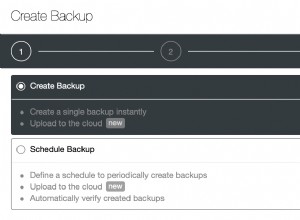Segui questi passaggi:
-
inserisci questo schema.sql nella cartella delle risorse per essere rilevato da SpringBoot una volta avviato il server. Se non usi l'avvio primaverile, non preoccuparti, importa questo script da qualsiasi client dell'app Mysql (phpmyadmin, HeidiSQL, Navicat..)
drop table if exists oauth_client_details; create table oauth_client_details ( client_id VARCHAR(255) PRIMARY KEY, resource_ids VARCHAR(255), client_secret VARCHAR(255), scope VARCHAR(255), authorized_grant_types VARCHAR(255), web_server_redirect_uri VARCHAR(255), authorities VARCHAR(255), access_token_validity INTEGER, refresh_token_validity INTEGER, additional_information VARCHAR(4096), autoapprove VARCHAR(255) ); drop table if exists oauth_client_token; create table oauth_client_token ( token_id VARCHAR(255), token LONG VARBINARY, authentication_id VARCHAR(255) PRIMARY KEY, user_name VARCHAR(255), client_id VARCHAR(255) ); drop table if exists oauth_access_token; create table oauth_access_token ( token_id VARCHAR(255), token LONG VARBINARY, authentication_id VARCHAR(255) PRIMARY KEY, user_name VARCHAR(255), client_id VARCHAR(255), authentication LONG VARBINARY, refresh_token VARCHAR(255) ); drop table if exists oauth_refresh_token; create table oauth_refresh_token ( token_id VARCHAR(255), token LONG VARBINARY, authentication LONG VARBINARY ); drop table if exists oauth_code; create table oauth_code ( code VARCHAR(255), authentication LONG VARBINARY ); drop table if exists oauth_approvals; create table oauth_approvals ( userId VARCHAR(255), clientId VARCHAR(255), scope VARCHAR(255), status VARCHAR(10), expiresAt TIMESTAMP, lastModifiedAt TIMESTAMP ); drop table if exists ClientDetails; create table ClientDetails ( appId VARCHAR(255) PRIMARY KEY, resourceIds VARCHAR(255), appSecret VARCHAR(255), scope VARCHAR(255), grantTypes VARCHAR(255), redirectUrl VARCHAR(255), authorities VARCHAR(255), access_token_validity INTEGER, refresh_token_validity INTEGER, additionalInformation VARCHAR(4096), autoApproveScopes VARCHAR(255) ); -
Inietta il tuo DataSource, AuthenticationManager, UserDetailsService all'interno del tuo OthorizationServer
@Autowired private MyUserDetailsService userDetailsService; @Inject private AuthenticationManager authenticationManager; @Autowired private DataSource dataSource; -
Dovrai creare questi due fagioli
@Bean public JdbcTokenStore tokenStore() { return new JdbcTokenStore(dataSource); } @Bean protected AuthorizationCodeServices authorizationCodeServices() { return new JdbcAuthorizationCodeServices(dataSource); }e per favore non dimenticare la @Configuration in cima alla tua classe AuthorizationServer
- Configura le app dei tuoi clienti da creare nel tuo database mysql:
clients.jdbc(dataSource).withClient("clientapp") .authorizedGrantTypes("password", "refresh_token") .authorities("USER") .scopes("read", "write") .resourceIds(RESOURCE_ID) .secret("123456");l'hai già fatto.
-
la cosa più importante (e penso che ve ne siate dimenticati..) è:configurare i vostri endpoint con AuthorizationServerEndpointsConfigurer:
endpoints.userDetailsService(userDetailsService) .authorizationCodeServices(authorizationCodeServices()).authenticationManager(this.authenticationManager).tokenStore(tokenStore()).approvalStoreDisabled();
e questo è tutto amico, ora dovrebbe funzionare;)
E sentiti libero di chiedere di più... Sarò felice di aiutarti
Ti ho mandato un messaggio da tweeter!




